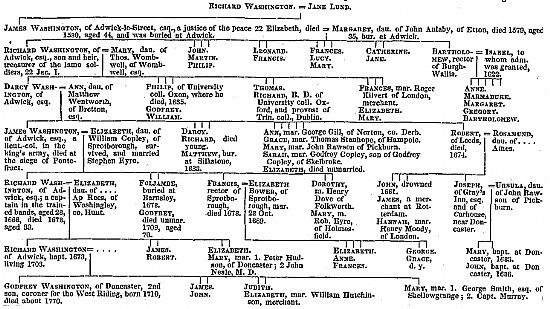The Washington family

Under one of the arches between the North chapel and the chancel there is an alter tomb with an alabaster slab which is a memorial to James Washington, who died in 1580, his wife Margaret and their children. The figure of an Elizabethan gentleman dressed in his ruff with the Washington Arms inscribed on his chest may be seen quite clearly, by his side is his wife and on her chest is the Analby Coat of Arms, their children are kneeling at their feet Though there had been a connection with the Washington family in previous times, it was in the middle of the sixteenth century that James Washington made his home in Adwick as Lord of the Manor. Soon Adwick Hall was built and was to remain the family home for well over one hundred years. James had a son, Richard who held office as treasurer for Lame Soldiers during the reign of James I and he in his turn was followed by his son, Darcy, who married Anne Wentworth a kinswoman of the Earl of Stafford. It was during his life time that the civil war broke out. The family were strong supporters of the Royalists and his son James, who was a Lt Col in the King’s forces was killed at the second siege of Pontefract. At the end of the host Adwick Hall was confiscated and only recovered with some difficulties. Gradually the fortunes of the family dwindled and the connection with Adwick closed in the early 18th century. There are documents to prove that Richard Washington sold off lots of land to Sir George Cooke of Owston in 1712 on the 9th of January. Enquiries have been made into the connection of this Washington family and the family of George Washington, who became the first President of the United States of America, he was born in 1732.George Washington in fact descended from John Washington of Salgrove Manor, who settled in Virginia in 1657.
Lineage
Augustine Washington was born in Westmoreland, Westmoreland County, Colony of Virginia, on November 12, 1694. He was a son of Lawrence Washington, a militia captain and a member of the Virginia House of Burgesses, and Mildred Warner.
His paternal grandparents were John Washington (c. 1631–1677) and his first wife, Anne Pope
Lawrence Washington was born in 1602, the fifth son of Lawrence Washington (b. 1565 d. 13 September 1616) of Sulgrave Manor, Northamptonshire, son and heir of Robert Washington (b. c. 1544 d. 1619), esquire, of Sulgrave by his first wife Elizabeth Lyte, daughter and heiress of Walter Lyte of Radway, Warwickshire. His mother was Margaret Butler (d. 16 March 1651), the eldest daughter and co-heiress of William Butler, esquire, of Tyes Hall in Cuckfield, Sussex, and Margaret Greeke, the daughter of Thomas Greeke, gentleman, of Palsters, Lancashire. Robert Washington was son of Lawrence Washington (b. c. 1500 d. 1584), eldest son of John Washington (b. c. 1465 d. 1528) of Warton, Lancashire, son of Robert Washington II (b. c. 1440 d. 1528), son of Robert Washington I (b. c. 1404 d. December 7, 1483), son of John Washington Jr (b. c. 1365 d. 1423), son of John Washington Sr (b. c. 1334 d. 1402), son of John Washington (b. 1304 d 1386), son of Robert de Washington Sr (b. c. 1265 d. 1324), son of Robert de Washington Sr (b. c. 1230 d. 1300), son of Robert de Washington (b. c. 1195 d. 1260), son of Walter de Washington (b. c. 1160 d. 1245), son of Bondo de Wassinggetun (b. c. 1122).

Pedigree of the Washington family of Adwick-le-Street
Arms: Argent, two bars, and three mullets in chief gules.
In the church at Adwick le Street - there were three altar tombs in the chantry to the Washington family; the oldest, dated 1579, is to " Dominus Jacobus Washington, armiger, de Adwycke," and has intaglios of the knight, his wife, and 12 children. On his breast he bears a shield with the stars and stripes, which are also figured on the shield round the tomb, and on the two other tombs.
Source: A key to English antiquities: with special reference to the Sheffield and Rotherham district. Ella Armitage


Further research from Yorkshire West Riding By Arthur Mee
Writing about the church at Adwick-le-Street:
The church shelters a tomb, and keeps green the memory of the Washingtons, who lived here the best part of two centuries, though their old home is no more.
Engraved on the tomb are the portraits of James Washington in Elizabethan armour and elaborate collar, his wife in a fashionable dress with a small ruff, and their 12 kneeling children. On the knights breast is the Washington shield with the stars and stripes, which were thus in this place long before they were on the American flag.
